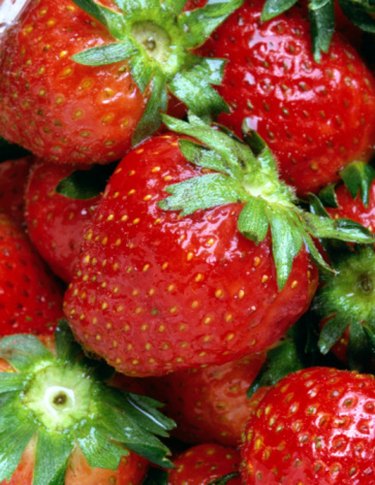
Home food growers must be able to recognize and treat any potential diseases on their crops, since growers typically intend to eat the food that they grow. Red leaves on a strawberry plant, for instance, is a telltale sign of red stele, a potentially serious disease of strawberry plants that requires immediate action from the grower to ensure both the safety of the strawberry fruit and the long-term health of the strawberry plant.
Red Stele
Video of the Day
The fungal disease agent Phytophthora fragariae causes red stele. Phytophthora fragariae lives in soil, commonly in moist, poorly drained, clay-laden soils that occur in cool weather. The disease is commonly spread by planting equipment or planting medium (potting soil, etc.) becoming contaminated with the fungus and being used on or near strawberry plants. Early spring, late winter and late fall see more incidences of this disease than do other times of the year since, at these times, soil conditions tend to be more conducive to growth of the Phytophthora fragariae fungus.
Video of the Day
Parallel Symptoms
The only way to confirm if the red leaves on your strawberry plants are a result of red stele is to observe your strawberry plants for the attendant symptoms of red stele. The earliest symptoms of this disease are stunted plant growth and a noticeable lack of the shiny luster that is characteristic of healthy strawberry plants. As the disease progresses, leaves turn red, blue, green and yellow and tend to take on a metallic sheen. The most important symptom of this disease is the titular red color that the stele, or center, of the root structure takes on. In its most advanced stages, red stele will kill the strawberry plant before the strawberry fruit fully ripens.
Natural and Preventative Control Methods
Phytophthora fragariae is known as an incredibly persistent fungus that can sometimes survive in soil for years even if no host plants are grown there. This persistence presents challenges for people growing strawberry plants. Preventative steps are the key to successful disease management. Since red stele is one of the most common and destructive diseases of strawberries, numerous strawberry cultivars with a high resistance to the disease are now available. Also carefully choose the soil in which the strawberries are planted; it should be well-drained, light and not compacted.
Chemical Controls
If your strawberry plants are already infected, however, control options are more limited. All diseased parts of the strawberry plant should be pruned off and discarded at once. Metalaxyl fungicides can be effective at controlling this disease but only when used in conjunction with proper cultural practices. The most effective way to prevent future strawberry plant destruction is to pull up the plants and plant a more-disease resistant strawberry cultivar in a different area of the garden with soil that is less conducive to Phytophthora fragariae growth.